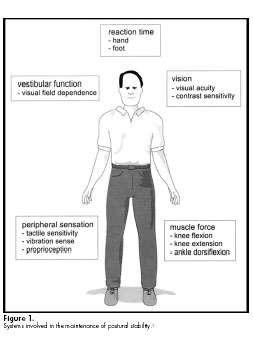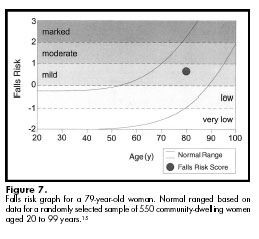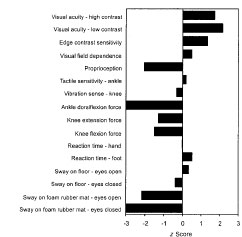Prediction of falls among the elderly at risk – Part II
Melanie Ng BSc Physiotherapy, SRP
Physiotherapist
Further investigation
Further investigation entails a close examination by a specialist to reassess and review medications, such as supplementation of Vitamin D, and psychotropic or anxiolytic medications, as well as carry out necessary tests to rule out any chronic medical conditions that may be contributing to the occurrence of falls. However one must not forget to asses and look closely to the physical conditions that may be further contributing to this scenario, with the help of a physiotherapist.
A specific physiological assessment needs to be carried out. This will provide the physiotherapist with objective measures indicating the changes in vision secondary to cataracts or diabetic neuropathy, proprioception, reaction time, postural sway (balance) and muscle strength which may also be playing a major role. According to Lord et al1 these 5 physiological components are the main factors that cause falls among the elderly.

Figure 1:
Source: http://www.ptjournal.org/cgi/reprint/83/3/237
This assessment provides the physiotherapist with the following tools:
- A graph indicating the individual’s overall falls risk score
- A table indicating the individual’s test performance in relation to age matched norms (Figure 2)
- A profile of the individual’s test performance with clear indication of the physiological strengths and weaknesses (Figure 3).
This allows for effective and efficient intervention on a physical level.
 |
 |
Figure 2: A patient’s test performance in relation to age matched norms
Source: http://www.ptjournal.org/cgi/reprint/83/3/237
Figure 3: A profile of a patient’s test performance with clear indication of the physiological strengths and weaknesses
Source: http://www.ptjournal.org/cgi/reprint/83/3/237
Interventions
Assessment is also valuable to determine what sort of intervention is deemed most appropriate for each patient. Furthermore the clinician must realize that different risk factors exist for different populations.
Hospital In-patients and Nursing Home Residents
Risk factors within such different environments are very different to those of the community dweller. Acute illness and a new environment are among some of the risk factors that are unique to these settings. The intervention which is deemed effective would be entirely different to that of a community dweller, example, more staff supervision, alarm calls, door magnets, more lighting, cubicle ergonomics, etc. Individuals suffering from dementia are also a risk population. This latter population is cognitively and physically frailer and therefore appropriate intervention may include the use of hip protectors.
The physiological assessment may be still used for individuals who may show signs of dementia. Therapists in the UK use the assessment to determine whether the patient is able to follow through, and from their performance determine the best intervention for the patient.
However the role of exercise as a means of reducing falls has been clearly stated in various studies.2 Walking as an exercise implementation to counteract falls, is not beneficial but rather places the individual more at risk of sustaining a fall. In fact falls in balance impaired individuals occur during walking and simultaneously performing a secondary task.3 Specific validated exercises focusing on balance and muscle strength of lower limbs have been found to minimize falls, and only then may be followed by a walking program.4
Falls Prevention Program which encourages behavioral changes to minimize the risk of falls is also beneficial. These programs are currently being set up in various hospitals and day centers in Australia and UK to meet this demand. I personally had the pleasure to set one of these programs up whilst working at the Prince of Wales Hospital in Sydney in 2006.
Locally, the Live Life Wellness Centre for Active Adults, is currently running varied sorts of exercise classes to promote active aging amongst our older population. Clients ranging up to 88 years of age are engaging in water and land activities focusing on balance and strength, as well as Pilates to promote back and abdominal strength. Live Life has recently also started organizing monthly walking groups for those who fear outdoor mobility. The aim is to encourage outdoor mobility, whilst socializing in a safe environment with supervision and promoting quality of life. Falls Risk assessments are carried out and there are plans for the near future to set up educational falls prevention programs, that will go hand in hand with the already running strength and balance exercise classes on land and in water.
There is a need for all health providers to increase local awareness on the importance of preventing falls and to change mind-sets that falls are inevitable at this age, by implementing behavioral changes.
References
1. Lord SR, Hylton BM, Tiedemann A (2003). A physiological Profile Approach to Falls Risk Assessment and Prevention. Physical Therapy. Vol 83. Number 3.
2. Guideline for the Prevention of Falls in Older Persons. Journal of the American Geriatrics Society 2001: 49(5): 554 – 672.
3. Melzer I, Kruz I, Shahar D, Levi M, Oddsson L (2007). Application of voluntary step execution test to identify elderly fallers. Age and Aging. 36: 532-537.
4. Taylor D, Stretton C (2004). The Otago Exercise Programme. An evidence based approach to falls prevention for older adults living in community. NJP Volume 31 Number 6.
Melanie Muscat is a physiotherapist working at the Live Life Wellness Centre for Active Adults, Prince of Wales Apartments, Manuel Dimech Street, Sliema. She can be contacted on info@livelife.com.mt. Alternatively you may visit: www.livelife.com.mt



